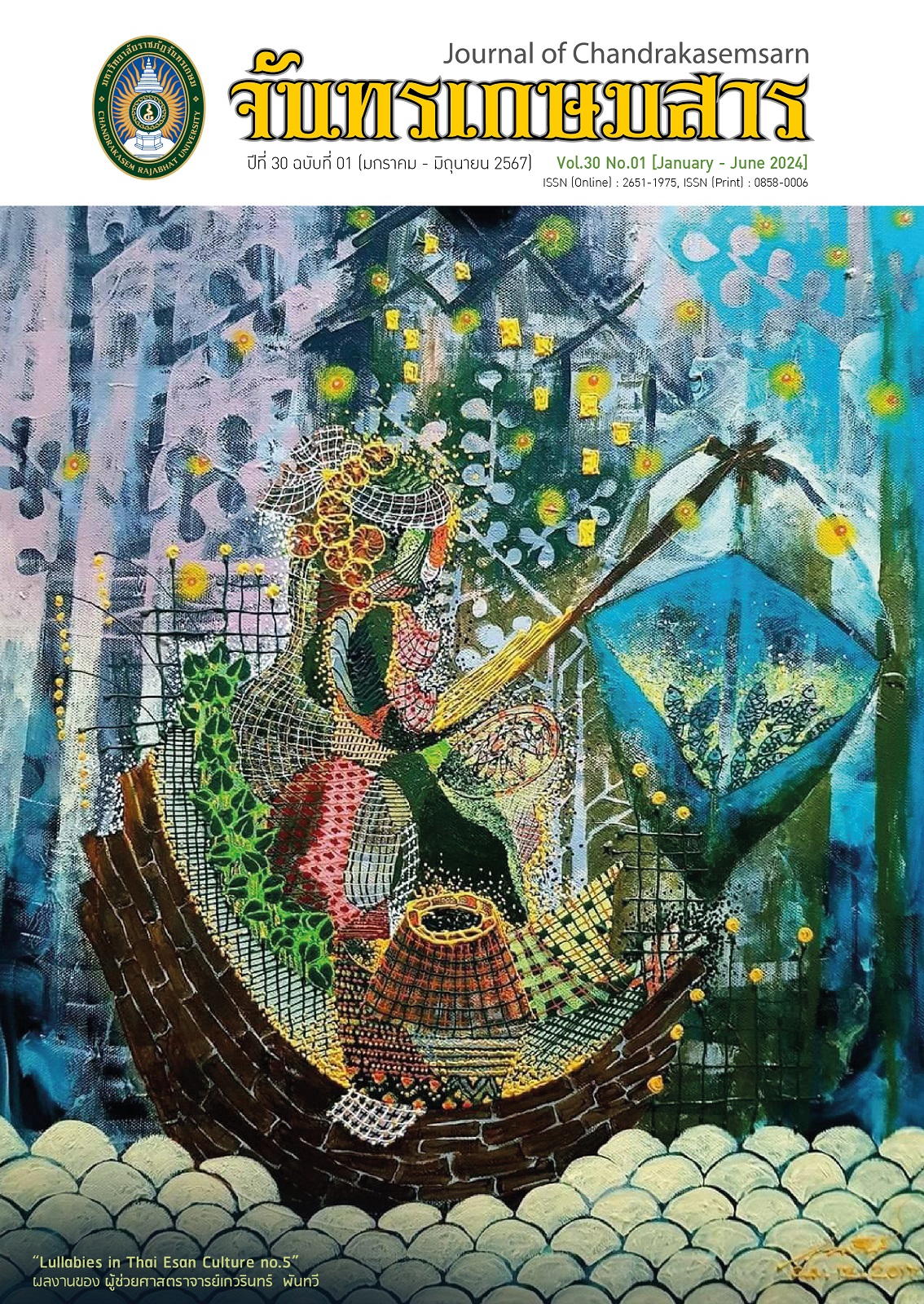The Role of Woven Textiles in Marriage and the After-Death Rituals of Tai Ethnic Groups in the Mekong River Basin
Keywords:
The Role of Woven Textiles, The Marriage Rituals, The After-Death Rituals, Tai Ethnic Groups in the Mekong River BasinAbstract
This article aims to study the role of woven textiles in marriage and the after-death rituals of Tai ethnic groups living in the Mekong River Basin: 1) Ban Phon Thong, Ban Phaeng District, Nakhon Phanom Province, Thailand; 2) Ban Ta Laew, Cham Phon District, Savannakhet Province, Lao PDR; and 3) Ban Ja, Xishuangbanna, Yunnan Province, People's Republic of China. Field data was collected from December 2022 to May 2023 with 15 key informants using in-depth and group interviews. Analyze the content data and present the data using descriptive analysis.
It was found that all three Tai ethnic groups also have ritual practices and rites of passage, including marriage ceremonies (Kin Dong or Kin Khaek) and after-death ceremonies (Ngan Huen Dee or Kun Tay). Hand-woven cloth is an essential symbolic object in rituals. In the marriage ceremony, women produce woven textiles and purchase the woven textiles to use as clothing, offerings, utensils, and bedding. As for the after-death ritual, the woven textiles will be used as funeral clothing and coffin covers. In addition to performing rituals to dedicate merit to the deceased, it is also popular to weave Tung or Thung to symbolize the deceased's spirit. The woven textile, therefore, reflects the way of life of the Tai ethnic group, which is associated with traditional and Buddhist beliefs. Regarding the role of woven textiles in life rituals, it was found that there are four roles, consisting of 1) the role of expressing the identity of women, 2) the role of expressing the worldview of the world after death, 3) the role of creating additional economic value for the community and, 4) the role of maintaining the cultural identity of the Tai people.
Downloads
References
ชนัญ วงษ์วิภาค. (2540). เครื่องนุ่งห่มและเอกลักษณ์กลุ่มชาติพันธุ์ในเอเชียตะวันออกเฉียงใต้. มหาวิทยาลัยศิลปากร.
ชนกมลย์ คงยก. (2558). “ผ้า” สื่อกลางระหว่างความเชื่อกับพิธีกรรม : กรณีศึกษา ผ้านาหมื่นศรีอําเภอนาโยง จังหวัดตรัง. วารสารรูสมิแร. 37(1), 79–96.
ประทับใจ สิกขา. (2555). ธุงอีสาน. มหาวิทยาลัยอุบลราชธานี.
ทรงศักดิ์ ปรางค์วัฒนากุล และแพทรีเซีย ซีสแมน แน่นหนา. (2542). ผ้าไทลื้อ : การผลิตซ้ำทางวัฒนธรรม. ใน ศิราพร ณ ถลาง และสุกัญญา ภัทราชัย (บ.ก.), คติชนกับคนไทย-ไท : รวมบทความทางด้านคติชนวิทยาในบริบททางสังคม (258-263). โครงการตำราคณะอักษรศาสตร์ จุฬาลงกรณ์มหาวิทยาลัย.
ภัคพล คำหน้อย. (2565). บทบาทหน้าที่และความเชื่อผ่านผ้าทอไทขึน : กรณีศึกษาหมู่บ้านต้น แหน อำเภอสันป่าตอง จังหวัดเชียงใหม่. วารสารวิชาการคณะมนุษยศาสตร์และสังคมศาสตร์ มหาวิทยาลัยราชภัฏพระนคร. 6(2), 35–51.
เมษ สอดส่องกฤษ. (2556). การจัดทำฐานข้อมูลกลุ่มชาติพันธุ์ในประเทศลุ่มน้ำโขง: กลุ่มชาติพันธุ์ในประเทศจีนตอนใต้ (ยูนนาน และกวางสี) ต้นสายธารอารยธรรมลุ่มน้ำโขง. มหาวิทยาลัยอุบลราชธานี.
ลิวอิส, เอ. โคเซอร์. (2535). Master of Sociological Thought: Ideas in Historical and Social Context [แนวความคิดทฤษฎีสังคมวิทยา ตอน เอมิล เดอไคม์]. (นฤจร อิทธิจีระจรัส, ผู้แปล). มหาวิทยาลัยธรรมศาสตร์.
วรรณา วุฒฑะกุล และยุรารัตน์ พันธุ์ยุรา. (2536). ผ้าทอกับวิถีชีวิตชาวไทย. สำนักงานคณะกรรมการวัฒนธรรมแห่งชาติ.
ศิราพร ณ ถลาง. (2562). คติชนสร้างสรรค์ : บทสังเคราะห์และทฤษฎี (พิมพ์ครั้งที่ 2). ศูนย์มานุษยวิทยาสิรินธร.
สุริยา สมุทคุปติ์ และพัฒนา กิติอาษา. (2536). ฮีตบ้านคองเมือง : รวมบทความทางมานุษยวิทยา ว่าด้วยสังคมและวัฒนธรรมอีสาน. โครงการจัดตั้งพิพิธภัณฑ์ทางมานุษยวิทยาของอีสาน ห้องไทยศึกษานิทัศน์สำนักวิชาเทคโนโลยีสังคม มหาวิทยาลัยเทคโนโลยีสุรนารี.
สุริยา สมุทคุปติ์, พัฒนา กิติอาษา, และนันทิยา พุทธะ. (2537). แม่ญิงต้องต่ำหูก: พัฒนาการ ของกระบวนการการทอผ้าและการเปลี่ยนแปลงบทบาทของผู้หญิงในหมู่บ้านอีสานปัจจุบัน. มหาวิทยาลัยขอนแก่น.
สุวัฒนา เลี่ยมประวัติ. (2551). การศึกษาภาษาถิ่น: ภาษาตระกูลไท. มหาวิทยาลัยศิลปากร.
สุวิไล เปรมศรีรัตน์, สุจริตลักษณ์ ดีผดุง, เอกพงศ์ สุวรรณเกษร์, อภิญญา บัวสรวง, อิสระ ชูศรี, โสภนา ศรีจำปา, มยุรี ถาวรพัฒน์, อมร ทวีศักดิ์, และประภาศรี ดำสอาด. (2547). แผนที่ ภาษาของกลุ่มชาติพันธุ์ต่าง ๆ ในประเทศไทย. โรงพิมพ์คุรุสภาลาดพร้าว.
อมรา ประสิทธิ์รัฐสินธุ์. (2548). ภาษาในสังคมไทย : ความหลากหลาย การเปลี่ยนแปลง และการพัฒนา (พิมพ์ครั้งที่ 4). โรงพิมพ์แห่งจุฬาลงกรณ์มหาวิทยาลัย.
Bascom, W. R. (1965). Four Functions of Folklore. In Alan Dundes (Eds.), The Study of Folklore. (pp. 279–298). Vintage Book.
Cheesman, P. (2007). Spirit Skirts of the Lao-Tai People of Laos. In Jane Puranananda (Eds.), The secrets of Southeast Asian textiles: myth, status and the supernatural. (pp. 134–149). River Books.

Downloads
Published
How to Cite
Issue
Section
License
Copyright (c) 2024 Chandrakasem Rajabhat University

This work is licensed under a Creative Commons Attribution-NonCommercial-NoDerivatives 4.0 International License.
บทความที่ได้รับการตีพิมพ์เป็นลิขสิทธิ์ของมหาวิทยาลัยราชภัฏจันทรเกษม
ข้อความที่ปรากฏในบทความแต่ละเรื่องในวารสารวิชาการเล่มนี้เป็นความคิดเห็นส่วนตัวของผู้เขียนแต่ละท่านไม่เกี่ยวข้องกับมหาวิทยาลัยราชภัฎจันทรเกษม และคณาจารย์ท่านอื่นๆในมหาวิทยาลัยฯ แต่อย่างใด ความรับผิดชอบองค์ประกอบทั้งหมดของบทความแต่ละเรื่องเป็นของผู้เขียนแต่ละท่าน หากมีความผิดพลาดใดๆ ผู้เขียนแต่ละท่านจะรับผิดชอบบทความของตนเองแต่ผู้เดียว






